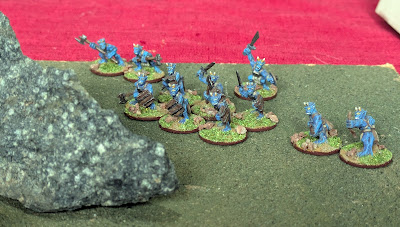I tried another game of Fantastic Scuffles yesterday, and went for two extremely different warbands.
The first used my Yokai figures and used three characters - the Tengu (skilled sword-fighting flier), the Oni (big strong giant) and the Jorogumo (seductive magical spider-woman). This was a chance to try out the spell-casting rules.
Against them I ran my Kobolds. They had one character (their leader) and then three groups of minions, most with swords, some with two-handed axes and two with bows.
The Yokai had to destroy an altar in the middle of the table. The Kobold leader had a grudge against the Oni and had to slay him. That would probably require some teamwork.
A party flees the table if all of its characters are killed (I got that wrong in an earlier game). he Kobolds have one character and he's not really up to much. So the Yokai decided to go for a quick win and send their fast-flying Tengu to perform a surgical strike on the Kobold's kaptain. Om the way he got hit by a couple o arrows from the Kobold archers.
He attacked the Kaptain and, amazingly, failed to even wound him.
The Oni ran towards the altar as his strength was useful for toppling it. He took a couple of arrows as well. Early on the archers performed really well.
Other kobolds came to the aid of their leader ...
... and they took down the Tengu!
So not a great start for the Yokai. The other kobolds spread out to cover the altar and gangup on the Oni. The Jorogumo wisely stayed out of the way; her skills were about confusion, charm and deception and she would come in useful once battle was joined.
She confused the first two kobolds to try and attack the Oni, preventing them from getting coordinated.
The Oni hadn't quite reached the altar and found himself under attack from several kobolds. He took some wounds but killed one of his attackers.
This caused some of the others to fall back.
The axe-men rushed in.
So did some of the swordsmen. The Oni killed one with a counter-strike. This forced a moral test on the others, some of whom fled. As they fled the Oni got in free hacks ...
... and killed two more of them.
The Kobolds were now scattered and had lost over half of their melee troops. The Oni and Jorogumo moved up to the altar; the latter could provide help in toppling it.
The Kobold kaptain was rushing into the fight; their win would depend on him killing the Oni and it looked like he'd have to do it single-handed.
Another kobold attacked the Jorogumo and wounded her.
The archers had a pop at the Oni, but their earlier luck deserted them.
The Kobold kaptain moved into the Oni's rear.
And charged, scoring a hit.
Keeping their eyes on the prize the Oni toppled the altar. The Yokai now just had to leave the board to get the full points for their mission.
This now left the Oni free to squish the annoying Kobold leader.
He swung and missed. And with his opportunity attack in response the wily kobold got in a telling blow to the vitals and downed the Oni.
This now left the Jorogumo alone, but all she had to do was escape. She fled across the shallow pond and stream; going the other way would take her past the Kobold kaptain. A couple of arrows flew past her. Neither hit.
She used her magic to scare off a few of her pursuers.
A kobold chased her across the stream and wounded her.
She made a run for it, but the Kobold Kaptain was on fire now and chased her down.
So this was a fairly decisive win for the Kobolds, who got the points for their objective and for killing three enemy characters. The Yokai got a few pints for toppling teh altar, but would have got more if one of them had escaped.
Possibly waiting around to topple the altar when the Kobold Kaptain attacked was a bad move by the Oni, who only had to kill the Kaptain for the Yokai to win by default.
The game generated a few questions to do with use of magic as well as timing of morale tests when a figure is killed, but overall everything worked OK and made sense. Both warbands were interesting to play, and came with their own benefits and challenges.























































